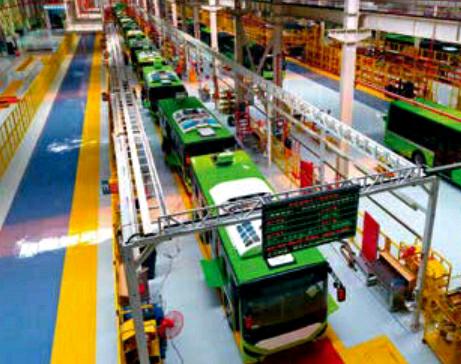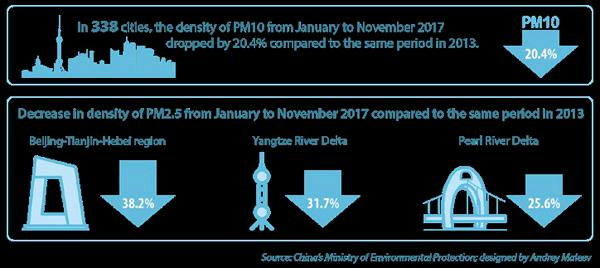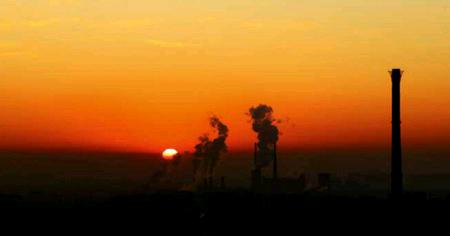Keeping the Skies Blue
2018-03-08byChongYatu
by+Chong+Yatu
On January 9, 2017, a BBC report on Beijings improved air quality this winter quoted Angelica Yang, a postgraduate student who has been living in Beijing for more than five years: “Last year you barely saw any faces on the streets—they were all covered up—but this year fewer people are wearing masks.”
Yangs words correlated with statistics issued by Chinas Ministry of Environmental Protection: In 2017, the concentration of fine particulate matter (PM2.5) dropped by one third. Beijings yearly average concentration of PM2.5 met an ambitious target set in 2013—it measured 58 micrograms per cubic meter, a 20.5-percent decrease yearon-year and a 35.6-percent decrease from 2013s 90 micrograms per cubic meter.
Smog plagued many places across the country, but the BeijingTianjin-Hebei region suffered the most, an area covering 190,000 square kilometers with considerable heavy industry and 110 million residents. The monthly report from Chinas Ministry of Environmental Protection showed that some cities in the area remained stuck at the bottom of the list in terms of air quality, especially in winter, at which time the concentration of PM2.5 could reach as high as 200 micrograms per cubic meter. However, in the winter of 2017, the air quality in the Beijing-Tianjin-Hebei region sharply improved.
Coal-to-Electric Switching
Despite Januarys subzero temperatures, Yuan Chunmings home in Qilindian Village of Baoding City, Hebei Province, stayed warm, and his potted plants were flourishing. “Now, we use electricity for the heating instead of coal,”Yuan announced excitedly. “Its more convenient to simply flip the heat on, and its also much cleaner. We only pay 25 yuan per square meter.”
At the main heating station of Qilindian Village, rows of air energy compressors are hard at work. “Our village chose electricity to replace coal,” explained Liu Junfeng, Party secretary of the village. “We built three heating stations in the village, which are funded and maintained by companies. Villagers just have to pay the heating fees.”
Qilindian Village changed its heating method, which provides a glimpse into the process of transforming the energy structure in the Beijing-Tianjin-Hebei region.
During bitter winters, many northern areas in China used to fire small coal stoves for heating. In 2016, the Ministry of Environmental Protection pointed out that China still depended primarily on fossil fuels like coal, which resulted in heavy air pollution in winter. For instance, the Beijing-Tianjin-Hebei region accounts for only 7.2 percent of Chinas land area, but was responsible for 33 percent of the nations coal burning that year, emitting about 30 percent of the total national pollutant.endprint
Since 2014, the Chinese government has invested huge sums in “coal-to-electricity” and “coal-tonatural gas” projects with an eye on decreasing pollution by using cleaner energy.
Statistics from the National Development and Reform Commission showed that over the past three years, the Beijing-TianjinHebei region has pumped 40 billion yuan into the projects, which benefit 4.7 million households.
Law-based Pollution Control
Previously, companies or individuals who obeyed the environmental protection law usually spent more money than those who ignored it. To comply with the law, businesses had to pay to upgrade their equipment, while violators would just pay a fine. In 2015, the newly amended Environmental Protection Law was enacted, which made the fine a daily payment and raised the cost 20 times over without specifying a maximum.
Additionally, the Chinese government set up a supervision mechanism to dispatch a team to various locales to investigate environmental issues of public interest and complaints. Within two years, the team has visited all provinces of the country, received 135,000 public petitions and fined 29,000 companies a total of 1.43 billion yuan. Also, the team investigated 1,518 cases, detained 1,527 suspects and placed liability on 18,000 persons.
Authorities also focused on enterprises with high energy consumption and high emissions. From October 1 to 3, 2017, Chinese Minister of Environmental Protection Li Ganjie led a team to Hebei, Shanxi, Shandong and Henan provinces to investigate shutting down, suspending or curtailing production of heavily polluting factories.
Two months before then, Chinas Ministry of Environmental Protection issued an action plan requiring 28 cities in the BeijingTianjin-Hebei region and nearby areas to shut down or suspend highly polluting enterprises in winter. And during times of peak pollution, all relevant factories were required to shift their production schedules, so as to reduce discharge of pollutants.
A series of specific measures were formulated and implemented. Henan Province issued an action plan that verified the specific times and requirements for shifting peak production for 3,060 enterprises in six industries including iron, steel, coking, casting and construction materials. The plan stipulated that iron and steel industries needed to limit production according to their levels of pollution.endprint
“Actually, limiting the production of polluting industries is painful for both the companies and local governments, but they must keep their eyes on the prize,” remarked chief scientist Chai Fahe of the Chinese Research Academy of Environmental Sciences. “In a long run, these high-polluting and outdated enterprises need to be weeded out. This is the key point.”According to him, while eliminating outdated capacity, local governments should divert more clean energy to production and improve their abilities to manage pollution. In industries like iron, steel, cement, glass, petrochemistry, chemistry and power plants, innovation in coal-fired boilers and breakthroughs in ultralow emissions technology are on the horizon.
Industrial Structure Adjustment
While promoting clean energy and controlling polluting enterprises, anti-smog centers and environmental protection police have emerged across the country to strengthen enforcement. According to Chai, over the past five years, China has set up a pollution management system featuring coordinated efforts from departments at all levels and from all walks of life, which has contributed to the great achievement China made in smog control.
However, using clean energy and shutting down or limiting highpolluting production are just quick fixes. The long-term solution is to adjust economic structure and optimize industrial layout. At the recent Central Economic Work Conference, the central government declared that China will continue to improve its environment by decreasing the discharge of major pollutants, adjusting industrial structure and eliminating outdated productivity as well as strengthening energy conservation and performance evaluations.
Also, the conference determined that environmentally friendly growth is an important facet of high-quality development and emphasized that a large-scale project would be launched to increase land greening and attract investments from state-own enterprises, private companies, foreign enterprises, social organizations, groups and individuals. The conference pledged to foster enterprises engaged in ecological protection and recovery.
“Switching energy resources and cutting pollution are aimed directly at the contamination sources,” said Chai. “The key is to adjust industrial structure, which is the current trend of Chinas development. In the past, we pursued a fast and no-nonsense model of development, which was decided by the times. But in the future, we will need high-quality, balanced and sustainable growth, which is high in demand during this new phase of development.” endprint
endprint